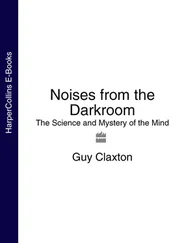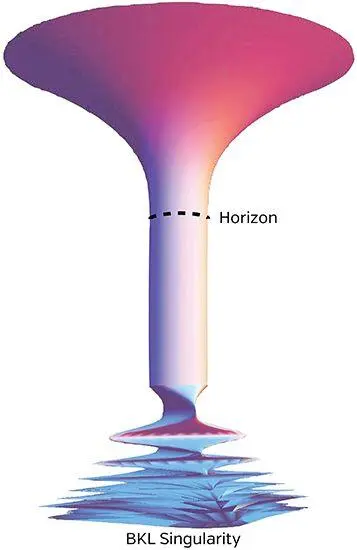
Fig. 26.10. The warped space of a fast-spinning black hole such as Gargantua, with the BKL singularity at the bottom. The chaotic stretch and squeeze near the singularity are depicted heuristically, not precisely.
All this and its chaotic pattern are described by Einstein’s relativistic laws. It is this that the Russians, B, K, and L, predicted. What they could not predict, what nobody can predict today, is the fate of your atoms and subatomic particles when the chaotic pummeling grows to an infinite crescendo. Only the laws of quantum gravity know their fate. But you, yourself, are long since dead, with no possibility to retrieve the quantum data and escape.
I labeled this section  for educated guess, because we are not absolutely certain that the singularity inside a black hole’s core is a BKL one. BKL singularities are surely allowed by Einstein’s relativistic laws. Garfinkle confirmed it by computer simulations. But more sophisticated simulations are needed to confirm that the BKL patterns of humongous stretch and squeeze do actually occur in the core of a black hole. I’m almost sure the result of those simulations will be “yes, they do occur.” But I’m not completely certain.
for educated guess, because we are not absolutely certain that the singularity inside a black hole’s core is a BKL one. BKL singularities are surely allowed by Einstein’s relativistic laws. Garfinkle confirmed it by computer simulations. But more sophisticated simulations are needed to confirm that the BKL patterns of humongous stretch and squeeze do actually occur in the core of a black hole. I’m almost sure the result of those simulations will be “yes, they do occur.” But I’m not completely certain.
A Black Hole’s Infalling and Outflying Singularities

My physicist colleagues and I were pretty sure in the 1980s, as an educated guess, that there is just one singularity inside a black hole, and it’s a BKL singularity. We were wrong.
In 1991 Eric Poisson and Werner Israel at the University of Alberta, Canada, working with the mathematics of Einstein’s laws, discovered a second singularity. This one grows with time as the black hole ages. It’s caused by extreme slowing of time inside the black hole.
If you fall into a spinning black hole such as Gargantua, lots of other stuff inevitably will fall in after you: gas, dust, light, gravitational waves, and so forth. This stuff may take millions or billions of years to enter the hole as seen by me, watching from outside. But as seen by you, now inside the hole, it may take only a few seconds or less, due to the extreme slowing of your time compared with mine. As a result, as seen by you this stuff all piles up in a thin sheet, falling inward toward you at the speed of light, or nearly the speed of light. This sheet generates intense tidal forces that distort space and will distort you, if the sheet hits you.
The tidal forces grow to become infinite. The result is an “infalling singularity” (Figure 26.11), [48] Israel and Poisson gave this singularity the name mass inflation singularity , and that is the name that physicists have used ever since. I prefer infalling singularity and use that name in this book.
governed by the laws of quantum gravity. However, the tidal forces grow so swiftly (Poisson and Israel deduced) that, if they hit you, they will have deformed you by only a finite amount at the moment you reach the singularity. This is explained in Figure 26.12, which plots your net stretch along the up-down direction and squeeze along the north-south and east-west directions, as time passes. When you hit the singularity, your net stretch and squeeze are finite, but the rates at which you are being stretched and squeezed (the slopes of the black curves) are infinite. Those infinite rates are the infinite tidal forces, signaling the singularity.
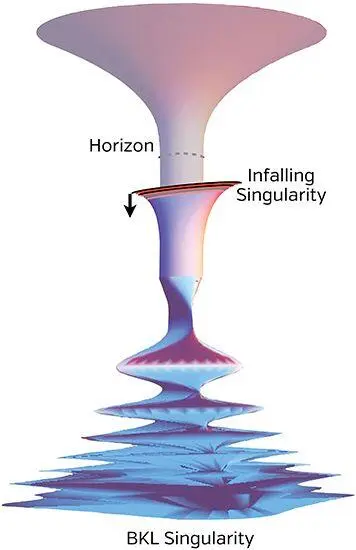
Fig. 26.11. The infalling singularity, created by stuff that falls into the black hole after you. The stuff is epitomized by alternating layers of black, red, gray, and orange.
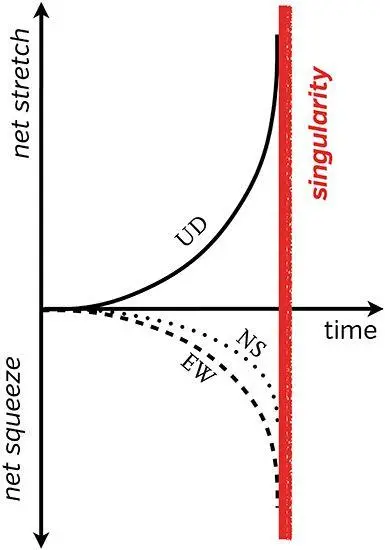
Fig. 26.12. Your net stretch and squeeze, as time passes, when the infalling singularity descends on you.
Because your body has been stretched and squeezed by only a finite net amount, when you reach the singularity, it is conceivable you might survive. (Conceivable but unlikely, I think.) In this sense, the infalling singularity is far more “gentle” than the BKL singularity. If you do survive, what happens next is known only to the laws of quantum gravity.
In the 1990s and 2000s, we physicists thought this was the whole story: A BKL singularity, created when the black hole is born. And an infalling singularity that grows afterward. That’s all.
Then in late 2012, while Christopher Nolan was negotiating to rewrite and direct Interstellar , a third singularity was discovered by Donald Marolf (University of California at Santa Barbara) and Amos Ori (The Technion, in Haifa, Israel). It was discovered, of course, via an in-depth study of Einstein’s relativistic laws and not via astronomical observations.
In retrospect, this singularity should have been obvious. It is an outflying singularity that grows as the black hole ages, just like the infalling singularity grows. It is produced by stuff (gas, dust, light, gravitational waves, etc.) that fell into the black hole before you fell in; Figure 26.13. A tiny fraction of that stuff is scattered back upward toward you, scattered by the hole’s warpage of space and of time, much like sunlight scattered off a curved, smooth ocean wave, which brings us an image of the wave.
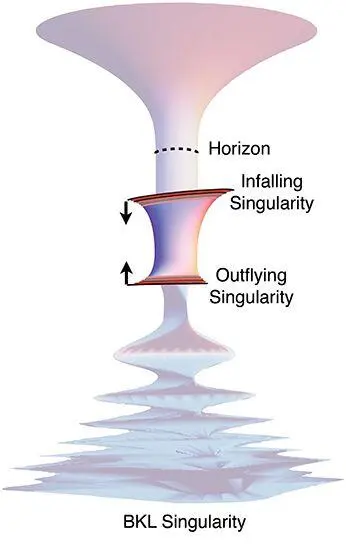
Fig. 26.13. The outflying singularity, created by back-scattered stuff that fell into the black hole before you; and the infalling singularity, created by stuff that falls in after you. You are sandwiched between them. Shown dimmed out is the exterior of the black hole and the BKL singularity, with which you can no longer have contact because they are beyond the singularities that sandwich you.
The upscattered stuff gets compressed, by the black hole’s extreme slowing of time, into a thin layer rather like a sonic boom (a “shock front”). The stuff’s gravity produces tidal forces that grow infinitely strong and thence become an outflying singularity . But as for the infalling singularity, so also for this outflying one, the tidal forces are gentle: They grow so quickly, so suddenly, that, if you encounter one, your net distortion is finite, not infinite, at the moment you hit the singularity.
In Interstellar , Romilly tells Cooper about these gentle singularities: “I have a suggestion for your return journey [from Mann’s planet]. Have one last crack at the black hole. Gargantua’s an older, spinning black hole. [It has] what we call a gentle singularity.” “Gentle?” Cooper asks. “They’re hardly gentle, but their tidal gravity is quick enough that something crossing the horizon fast might survive.” Cooper, lured by this conversation and the quest for quantum data, later plunges into Gargantua (Chapter 28). It’s a brave plunge. He can’t know in advance whether he’ll survive. Only the laws of quantum gravity know for sure. Or the bulk beings…
We’ve now laid the extreme-physics foundations for Interstellar ’s climactic scenes, so let’s turn to the climax.
Читать дальше
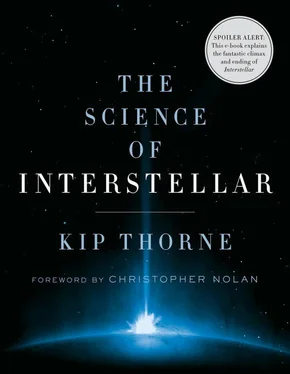

 for educated guess, because we are not absolutely certain that the singularity inside a black hole’s core is a BKL one. BKL singularities are surely allowed by Einstein’s relativistic laws. Garfinkle confirmed it by computer simulations. But more sophisticated simulations are needed to confirm that the BKL patterns of humongous stretch and squeeze do actually occur in the core of a black hole. I’m almost sure the result of those simulations will be “yes, they do occur.” But I’m not completely certain.
for educated guess, because we are not absolutely certain that the singularity inside a black hole’s core is a BKL one. BKL singularities are surely allowed by Einstein’s relativistic laws. Garfinkle confirmed it by computer simulations. But more sophisticated simulations are needed to confirm that the BKL patterns of humongous stretch and squeeze do actually occur in the core of a black hole. I’m almost sure the result of those simulations will be “yes, they do occur.” But I’m not completely certain.



